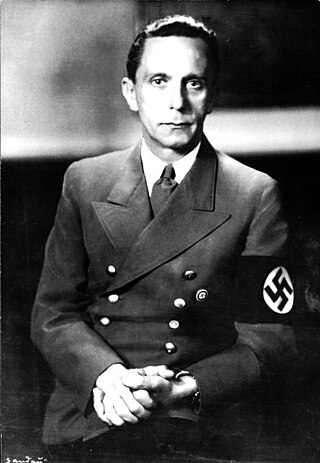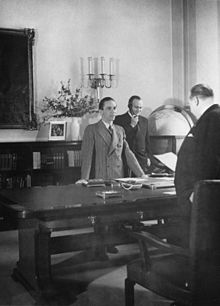
Degenerate art was a term adopted in the 1920s by the Nazi Party in Germany to describe modern art. During the dictatorship of Adolf Hitler, German modernist art, including many works of internationally renowned artists, was removed from state-owned museums and banned in Nazi Germany on the grounds that such art was an "insult to German feeling", un-German, Freemasonic, Jewish, or Communist in nature. Those identified as degenerate artists were subjected to sanctions that included being dismissed from teaching positions, being forbidden to exhibit or to sell their art, and in some cases being forbidden to produce art.

Degenerate music was a label applied in the 1930s by the government of Nazi Germany to certain forms of music that it considered harmful or decadent. The Nazi government's concerns about degenerate music were a part of its larger and better-known campaign against degenerate art. In both cases, the government attempted to isolate, discredit, discourage, or ban the works.

Adolf Ziegler was a German painter and politician. He was tasked by the Nazi Party to oversee the purging of what the Party described as "degenerate art", by most of the German modern artists. He was Hitler's favourite painter. He was born in Bremen and died in Varnhalt, today Baden-Baden.

The Nazi regime in Germany actively promoted and censored forms of art between 1933 and 1945. Upon becoming dictator in 1933, Adolf Hitler gave his personal artistic preference the force of law to a degree rarely known before. In the case of Germany, the model was to be classical Greek and Roman art, seen by Hitler as an art whose exterior form embodied an inner racial ideal. It was, furthermore, to be comprehensible to the average man. This art was to be both heroic and romantic. The Nazis viewed the culture of the Weimar period with disgust. Their response stemmed partly from conservative aesthetics and partly from their determination to use culture as propaganda.

Karl Christian Ludwig Hofer or Carl Hofer was a German expressionist painter. He was director of the Berlin Academy of Fine Arts.

Johann Heinrich "Hans" Hinkel was a journalist, Nazi Party official and politician in Nazi Germany. He mainly worked in the Reich Chamber of Culture and the Reich Ministry of Propaganda. He was involved in executing the policy of excluding Jews from German cultural life, and headed the Ministry's film division. He was also an SS-Gruppenführer, and was imprisoned in Poland for several years after the end of the Second World War.

The Reich Ministry for Public Enlightenment and Propaganda, also known simply as the Ministry of Propaganda, controlled the content of the press, literature, visual arts, film, theater, music and radio in Nazi Germany.

Anti-Jewish legislation in pre-war Nazi Germany comprised several laws that segregated the Jews from German society and restricted Jewish people's political, legal and civil rights. Major legislative initiatives included a series of restrictive laws passed in 1933, the Nuremberg Laws of 1935, and a final wave of legislation preceding Germany's entry into World War II.
Jüdischer Kulturbund, or Der Jüdische Kulturbund, was a cultural federation of German Jews established in 1933. It hired over 1,300 men and 700 women artists, musicians, and actors fired from German institutions. According to Jonathan C. Friedman, it grew to approximately 70,000 members, while Saul Friedländer tallies its roster as high as 180,000.
Israelitisches Familienblatt was a Jewish weekly newspaper, directed at Jewish readers of all religious alignments. Max Lessmann and Leo Lessmann founded the Familienblatt, which was published by the printing and publishing house Buchdruckerei und Verlagsanstalt Max Lessmann first in Hamburg, and then in Berlin (1935–1938). The Familienblatt was the only newspaper dealing with majorly Jewish issues in Germany which was run by a private business not aligned to a Jewish organisation of any kind. The editorial and printing offices were located in ABC-Straße 57 in Hamburg. The Hamburg agglomeration, consisting of the Free and Hanseatic City of Hamburg, the Danish-Holsteinian cities of Altona and Wandsbek as well as the Hanoverian city of Harburg upon Elbe, had been an important Jewish centre in Europe and in number with c. 9,000 persons, the biggest in Germany. Only by the first third of the 19th century did Berlin, Prussia's capital, overtake with Jews migrating from the former Polish provinces, which Prussia annexed in the Polish Partitions. Originally directed to readers in Hamburg's metropolitan area the Familienblatt gained more and more readers and spread nationwide in Germany. Israelitisches Familienblatt was prohibited to appear any further after the November Pogroms on 9–10 November 1938.

The Reich Chamber of Music was a government agency which operated as a statutory corporation controlled by the Ministry of Public Enlightenment and Propaganda that regulated the music industry in Nazi Germany between 1933 and 1945. It promoted "good German music" which was composed by Aryans and seen as consistent with Nazi ideals, while suppressing other, "degenerate" music, which included atonal music, jazz, and, especially, music by Jewish composers. The Chamber was founded in 1933 by Joseph Goebbels as part of the Reich Chamber of Culture, and it operated until the fall of the Nazi Germany in 1945.

Music in Nazi Germany, like all cultural activities in the regime, was controlled and "co-ordinated" (Gleichschaltung) by various entities of the state and the Nazi Party, with Propaganda Minister Joseph Goebbels and the prominent Nazi theorist Alfred Rosenberg playing leading – and competing – roles. The primary concerns of these organizations was to exclude Jewish composers and musicians from publishing and performing music, and to prevent the public exhibition of music considered to be "Jewish", "anti-German", or otherwise "degenerate", while at the same time promoting the work of favored "Germanic" composers, such as Richard Wagner and Anton Bruckner. These works were believed to be positive contributions to the Volksgemeinschaft, or German folk community.

The Degenerate Art exhibition was an art exhibition organized by Adolf Ziegler and the Nazi Party in Munich from 19 July to 30 November 1937. The exhibition presented 650 works of art, confiscated from German museums, and was staged in counterpoint to the concurrent Great German Art Exhibition. The day before the exhibition started, Adolf Hitler delivered a speech declaring "merciless war" on cultural disintegration, attacking "chatterboxes, dilettantes and art swindlers". Degenerate art was defined as works that "insult German feeling, or destroy or confuse natural form or simply reveal an absence of adequate manual and artistic skill". One million people attended the exhibition in its first six weeks. A U.S. critic commented, "There are probably plenty of people—art lovers—in Boston, who will side with Hitler in this particular purge". This particular take is controversial, however, given the greater political context of the exhibition.
Hans Severus Ziegler was a German publicist, theater manager, teacher and Nazi Party official. A leading cultural director under the Nazis, he was closely associated with the censorship and cultural co-ordination of the Third Reich.
Rainer Schlösser was a German journalist and writer who held (1933–1945) the governmental post of Reichsdramaturg in the Ministry of Popular Enlightenment and Propaganda headed by Joseph Goebbels and also President of the Reichstheaterkammer or Reich Theatre Chamber, the state governing body for drama. This was an even more important and high-profile position. The equivalent body in the world of music, the Reichsmusikkammer, was headed by the world-famous composer Richard Strauss from 1933 to 1935.

Wolfgang Willrich was a German artist of the 20th century, who created propaganda art during the time of Nazi Germany. In 1933, Willrich was employed by the Nazi government, for which he drew art depicting idealized racial standards and portraits of soldiers and party officials.
The Reich Music Days (German: Reichsmusiktage} took place from 22 to 29 May 1938 in Düsseldorf. They were a Nazi propaganda event under the patronage of Joseph Goebbels. Goebbels had originally planned an annual return of the Reichsmusiktage. These were held again in May 1939, but ceased to exist after the beginning of the Second World War.
Karl Buchholz was one of Hitler's Nazi art dealers specialized in selling looted "Degenerate Art".
The Große Deutsche Kunstausstellung was held a total of eight times from 1937 to 1944 in the purpose-built Haus der Deutschen Kunst in Munich. It was representative of art under Nazism.















